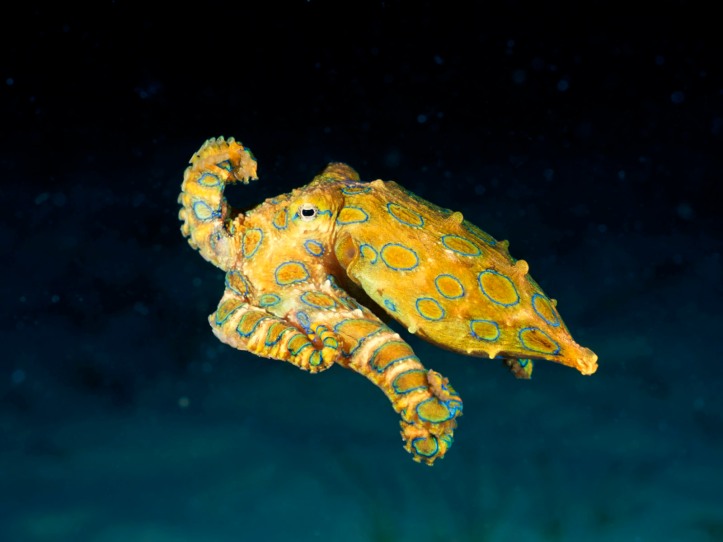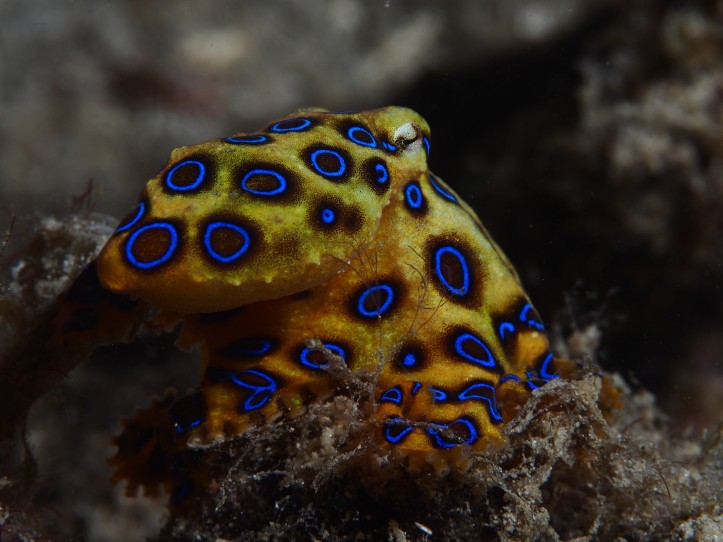An ocean inhabitant whose venom outweighs any land animal’s, the tiny blue-ringed octopus contains enough venom to kill ten adult humans, all weighing a healthy 75kg.
The main aggressor in this venom is tetrodotoxin, an extremely potent neurotoxin that still has no antivenom available. Within 10-15 minutes numbness occurs around the mouth followed by a creeping paralysis that without CPR and life supporting machines, ultimately leads to death as the lungs collapse and the brain is starved of oxygen.
So yes, it’s pretty freakin’ venomous – but why?

Very recently, I was speaking to someone about these octopuses (Hapalochlaena spp.) when they remarked “it just seems unreasonable, something so small being so venomous”, and while yes they are small (the largest of three confirmed species only reaches 20cm in length), a small size is often why being venomous can be so beneficial.
Tricky Prey
Small animals with a taste for tricky-to-catch prey usually can’t rely on strength and stature to win their meal. Introduce deadly venom to the mix however, and the playing field begins to level.
So is the case for a blue-ringed octopus; who, small and soft-bodied, needs to use extreme caution around the claws of the crabs it likes to eat. Their strong venom is essential to immobilise this prey so they can chomp away in safety.
As a general rule, the more difficult to handle, the more resistant or the larger the prey animal, the stronger the dose of venom dished out by the predator.
Venom Costs
Delivering venom however, is not just costly to the victim. Venoms are rich in proteins and require a lot of energy from the predator to produce. This is why many snakes sometimes give ‘dry bites’ where no venom is delivered and why some species have got rid of venom altogether. For example uloborid spiders are no longer venomous and kill only by wrapping prey in silk.
So maybe these octopuses are so venomous, yet so small, because they trade energy spent growing big, into energy spent housing venom. They are some of the smallest octopus species known and by far the most venomous.
And even though they don’t make the tetrodotoxin in their venom per se (bacteria living inside them produce it instead), there could still be considerable costs maintaining a relationship with the bacteria and in making sure they’re physiologically immune to the toxins they produce.

Eight-arms Race
Finally, the blue-ringed octopus may seem unreasonably venomous to us, because we haven’t evolved alongside it fighting in an ‘arms race’. This race describes the long-term battle between the blue-ringed octopus and its prey, where their venom grows increasingly strong over time in response to any increased resistance in their prey.
By not being a part of this race, it’s like our bodies have entered an exam unprepared. We missed all the lectures and sit the tetrodotoxin test without any prior knowledge on how to cope. Unsurprisingly, we do not pass.
Take green turtles too; despite sharing the same ocean space with one species of blue-ringed octopus (Hapalochlaena fasciata), they’re not part of their diet and accidentally swallowing one also results in death.
What green turtles can eat however, are box jellyfish! Although another incredibly deadly animal to us, the many millions of years green turtles have been eating jellyfish have seen them win this arms race, and evolve resistance to the box jellyfish’s powerful sting.

So is it their tricky-to-catch prey, their small size or the effect of their eight-arms race that make the blue-ringed octopus seem so ridiculously venomous? I can’t say for sure, but most likely it’s a combination of all these factors – and more!
What I will say is don’t touch a blue-ringed octopus.
With an outcome of body paralysis and possible death, I think we can all agree it’s best to leave that Viking-strong venom for the crabs, hey?
References
Bonnet, M. S. (1999). The toxicology of Octopus maculosa: The blue-ringed octopus. British Homoeopathic Journal, 88(4), 166-171.
Fry, B. G., Roelants, K., & Norman, J. A. (2009). Tentacles of venom: toxic protein convergence in the Kingdom Animalia. Journal of molecular evolution, 68(4), 311-321.
Hamner, W. M., Jones, M. S., & Hamner, P. P. (1995). Swimming, feeding, circulation and vision in the Australian box jellyfish, Chironex fleckeri (Cnidaria: Cubozoa). Marine and Freshwater Research, 46(7), 985-990.
Morgenstern, D., & King, G. F. (2013). The venom optimization hypothesis revisited. Toxicon, 63, 120-128.
Townsend, K. A., Altvater, J., Thomas, M. C., Schuyler, Q. A., & Nette, G. W. (2012). Death in the octopus’ garden: fatal blue-lined octopus envenomations of adult green sea turtles. Marine biology, 159(3), 689-695.
Williams, B. L. (2010). Behavioral and chemical ecology of marine organisms with respect to tetrodotoxin. Marine Drugs, 8(3), 381-398.
Williamson, J. A. (1987). 18 The blue-ringed octopus bite and envenomation syndrome. Clinics in dermatology, 5(3), 127-133.
Good article, with fantastic photos. Thanks for the info on the interspecies arms-race!
LikeLike
The grumpy looking green turtle is definitely a favourite of mine haha. Really glad you found it interesting, thank you!
LikeLike
Great post!
LikeLike
[…] what i’ve been up to of late. So please, look away now if you’re after something with super venom or an odd number of genitals, as I have […]
LikeLike